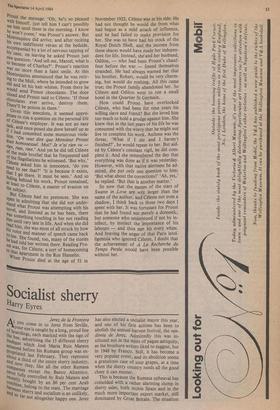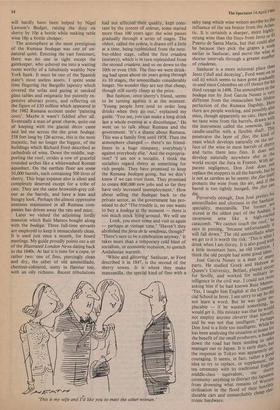Socialist sherry
Harry Eyres
Jerez de la Frontera Jerez de la Frontera
You come in to Jerez from Seville, of eye is caught by a long, proud lineofhoardings, each marked with the sign of
th bee, advertising the 15 different sherry 3degas which Jose Maria Ruiz Mateos amassed before his Rumasa group was ex- abpriated last February. They represent abut a third of the entire sherry industry, aersricl now they, like all the other Rumasa ,s'inPanies except the Banco Altantico, urever fully controlled by Ruiz Mateos and ce,,centlY bought by an 80 per cent Arab b:frnbine, belong to the state. The marriage a'_,ween sherry and socialism is an unlikely, "u so far not altogether happy one. Jerez has also elected a socialist mayor this year, and one of his first actions has been to abolish the annual harvest festival, the yen- dimia de Jerez. Admittedly this was in- stituted not in the mists of pagan antiquity, as the brochure writers liked to suggest, but in 1948 by Franco. Still, it has become a very popular event, and its abolition seems a gratuitous case of sour grapes, at a time when the sherry country needs all the good cheer it can muster.
This is because the Rumasa upheaval has coincided with a rather alarming slump in sherry sales, both within Spain and in the much more important export market, still dominated by Great Britain. The situation
will hardly have been helped by Nigel Lawson's Budget, raising the duty on sherry by 10p a bottle while making table wine 18p a bottle cheaper.
The atmosphere at the most prestigious of the Rumasa bodegas was one of un- natural quiet. Entering the vast forecourt, there was no one in sight except the gatekeeper, who ushered me into a waiting room worthy of a fabulously wealthy New York bank. It must be one of the Spanish state's most useless assets. I spent some time fingering the Bargello tapestry which covered the sofas and gazing at smoked glass tables and enigmatic but patently ex- pensive abstract prints, and reflecting on the figure of £10 million which appeared in the 1982 Rumasa account under 'painting costs'. Maybe it wasn't fiddled after all. Eventually a man of great charm, quite out of keeping with the glacial decor came and led me across the the great bodega. 558 feet long by 126 across, this is the most majestic, but no longer the biggest, of the buildings which Richard Ford described as cathedrals of wine. Down the middle, sup- porting the roof, strides a row of graceful rounded arches like a whitewashed Roman aqueduct. On the earthen floor are some 10,000 barrels, each containing 500 litres of sherry. This huge expanse also is silent and completely deserted except for a tribe of cats. They are the same brownish-grey col- our as the barrels, and have a lean and hungry look. Perhaps the almost oppressive neatness maintained in all Rumasa com- panies has driven away the rats and mice.
Later we visited the adjoining lordly mansion which Ruiz Mateos bought along with the bodega. Three full-time servants are employed to keep it immaculately clean. It is used just once a month, for board meetings. My guide proudly points out a set of the Illustrated London News dating back to the 1840s. At last it is time for a copa, or rather two: one of fino, piercingly clean and dry, the other of old amontillado, chestnut-coloured, nutty in flavour too, with an oily richness. Recent tribulations had not affected their quality, kept cons- tant by the system of soleras, some started more than 100 years ago: the wine passes gradually through a series of stages. The oldest, called the solera, is drawn off a little at a time, being replenished from the next- but-oldest stage, called the first criadera (nursery), which is in turn replenished from the second criadera, and so on down to the 10th or even 15th. The fino we were drink- ing had spent about six years going through its 10 stages, the amontillado considerably longer. No wonder they are not that cheap, though still surely cheap at the price.
But fashion, once sherry's friend, seems to be turning against it at the moment. `Young people here tend to order long drinks when they go out,' explained my guide. 'You see, you can make a long drink last a whole evening at a discotheque.' He went on to talk about Rumasa and the government. 'It's a shame about Rumasa. This was a family firm until 1978. Then the atmosphere changed — there's no friend- liness in a huge company, everybody's against everybody else.' And the expropria- tion? 'I am not a socialist. I think the socialists regard sherry as something for rich people. They have promised to keep the Rumasa bodegas going, but we don't know if we can trust them. They promised to create 800,000 new jobs and so far they have only increased unemployment.' How about selling the bodegas back to the private sector, as the government has pro- mised to do? 'The trouble is, no one wants to buy a bodega at the moment — there is too much stock lying around. We will see ... Look, you must come and visit us again — perhaps at vintage time.' Haven't they abolished the feria de la vendimia, though?' 'There's sure to be a celebration anyway.' It takes more than a temporary cold blast of socialism, or economic recession, to quench Andalusian warmth.
'White and glittering' Sanlucar, as Ford described it in 1847, is the second of the sherry towns. It is where they make manzanilla, the special kind of fino with a 'This is my wife and I'd like you to meet the other woman.' The Spectator 14 April 1984 salty tang which wine writers ascribe to the influence of the sea breeze from the Atlan- tic. It is certainly a sharper, more highlY" strung wine than the finos from Jerez or 0 Puerto de Santa Maria, but that could also be because they pick the grapes a week earlier in Sanlucar, and move the wine at shorter intervals through a greater number of criaderas. Sanlucar is a more informal place than Jerez ('dull and decaying', Ford went on to call it) which seems to have gone gradually to seed since Columbus set off thence for his third voyage in 1498. The atmosphere in the bodega run by Jose Garcia Nunez is very perfectiondifferent from o f the ht he e Rumasai m macu immaculate flagship. Here there are people working, and possibly also mice, though apparently no cats. Here also we taste wine from the barrels, drawn with the instrument called the venencia, like .3 candle-snuffer with a flexible shaft. This, penetrates the layer of for, the kind 01 yeast which develops naturally on the sur- face lifeless face of the wine in most barrels of sherry and turns them into fino. It does not develop naturally anywhere else in the world except the Jura in France. With aP: parent negligence, Don Jose does 11°` replace the stoppers in all the barrels, but h,ee, is not as careless as he seems: the flor ns protects the wine from the air, and if the barrel is too tightly bunged, the for can die. Perversely enough, Don Jose prefers his amontillados and olorosos to the Sanlucar speciality, manzanilla. The former are stored in the oldest part of the bodega, cavernous area like a hig114°°,fte„ catacomb. 'We cannot touch the roof, ":: says in passing, 'because unfortunately it will fall down.' The old amontillado when we get to it is worth the risk: 'This is what I I drink when I am thirsty. It is also good ',silt ,
a little mountain ham, an old dea
tradodition.
think the old people had some go Jose Garcia Nunez is a man of rrtafY
at parts. He studied Greek and Hebrew Queen's University, Belfast, played sc)Cer for Seville, and worked for military tr..
_
telligence in the civil war. I could not resist asking him if he had known Ruiz Mate osr: 'Yes, I taught him English at the Cornerle.d coal School in Jerez. I am sorry to say he not learn a word. But he placable — if he wanted something, utd would get it. His mistake was that heviclf not employ anyone cleverer than Ionise ; and he was not that intelligent.' perhaps Don Jose is a little too intelligent. While for has been analysing the situation at home the benefit of the small producers, a bolus down the road has been sending its s„t manager out to Japan. It is early days, Was quite iTe the response in Tokyo was apparently e_uci couraging. It seems, in fact, rather a 0;9he idea to try to replace, or supPleglerit' lisp tea ceremony with its traditional Eng ' middle-class equivalent, the sheen; ceremony: anything to distract the Japan in from drowning what remains of Wes.ebty civilisation in the flood of their horrl,ec.. tdruornaibclehacradrws hardware. unmatchably cheap el











































 Previous page
Previous page